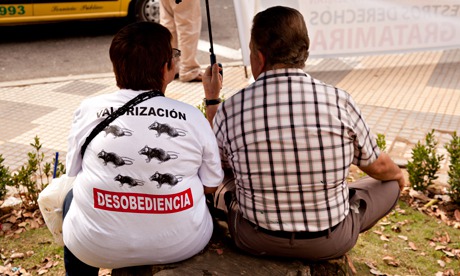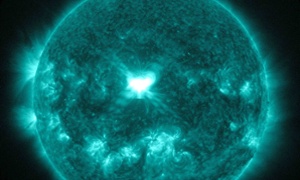More than two decades after the cold war, during which the US backed anti-communist military rulers and pushed free-market policies in Latin America, conservative governments have virtually disappeared from the region.
The leftward shift has been under way since the start of the millennium, but in recent years, the political axis of the hemisphere has tilted even further, as candidates who promise greater social spending and wealth redistribution win again and again. When the term of Chilean conservative Sebastián Piñera ends in March, right-leaning presidents will be in power only in small Central American nations and Paraguay.
"I think it's difficult for conservative candidates to move forward because inequality is such an entrenched issue," said Ana Quintana, a Latin America expert at the Heritage Foundation in Washington. "And it's hard to implement free-market, institutional reforms when you need to make sure a significant portion of the population can get enough to eat."
Latin America's right could once identify itself as pro-business and supportive of law and order and as closely aligned with the US. But many of the region's leftists and centrists have co-opted some of those issues as they have become more moderate, regional observers say, leaving conservatives with less to run on.
"I think the right is struggling to define itself in the new environment," said Carl Meacham, the Americas director at the Centre for Strategic and International Studies in Washington.
Meacham, who was a policy adviser to former Republican Senator Richard Lugar of Indiana, said Latin America's conservatives could do more to emphasise "market approaches to increased social mobility", rather than the state-oriented strategies offered by leftists.
"Folks in current leadership positions on the right don't seem to have the answers," he said. "We need a reset and new, younger voices."
While dominant, Latin America's leftists are hardly a monolithic bloc, and significant policy differences have emerged, especially on matters of trade protectionism and relations with the US.
But in big, geopolitical ways, the region has undergone a massive realignment. With Washington's diplomatic attention largely focused elsewhere, on Asia and the Middle East, Latin America's shift has resulted in declining US influence.
Evidence of this will be on display this week, when 33 heads of state and top officials are due to meet in Havana for a summit of the Community of Latin American and Caribbean States(Celac), a regional organisation founded in 2011 as an alternative to the Washington-based Organisation of American States (OAS).
The summit's host will be Cuba's 82-year-old leader, Raúl Castro.
While the fledgling organisation has played mostly a symbolic role so far, its meeting – in communist-run Cuba, of all places – is especially notable given that no date has been set for the next Summit of the Americas, the OAS-sponsored gatherings that have until now been Latin America's most important multilateral assemblies.
At the last summit, held in Colombia in April 2012, leaders from across the hemisphere's political spectrum displayed rare consensus by insisting that future summits should not exclude Cuba, which is not an OAS member. The summit's agenda was largely obscured by a prostitution scandal among the secret service agents sent to guard President Barack Obama.
Celac was partly the creation of late Venezuelan ruler Hugo Chávez, who viewed it as a vehicle for the long-lost Latin American integration dreams of his idol, 19th-century independence hero Simón Bolívar.
With Chávez's death last March, the more radical end of Latin America's left is without a clear leader. His successor, Nicolás Maduro, is viewed as far too preoccupied with his own political survival to try to assume his mantle.
"Maduro is no international leader," said José Rafael Zanoni, a former Venezuelan ambassador to Egypt and Iran. "He's not even a leader in Venezuela."
If anything, the strong-armed statist model that Chávez promoted during his 14-year rule has served as a cautionary tale for leftist candidates in the region.
They are quicker to identify with the path charted by Brazil's popular former president Luiz Inácio Lula da Silva, characterised by greater social spending on the poor but also an embrace of private enterprise and global capital.
The Chavez-v-Lula comparison became an oversimplified prism for the region's leftist tendencies, analysts say, but it remains a useful gauge.
"The two defining elements are relations with the United States and relations with the private business community," said Carlos Romero, a foreign affairs analyst in Caracas. "Venezuela represents the extreme."
Still, in Argentina, Bolivia, Ecuador and Nicaragua, the Chávez school remains strong, as leftists in those countries have thrived through increased confrontation with Washington, the concentration of executive power and in many cases, attempts to stifle the press and political opponents.
But in other countries, particularly in Central America, Washington continues to wield enormous influence. In Honduras, locals still refer to the US diplomatic mission as "The Embassy", as if it were the only one in the country.
Farther south, Latin American relations have diversified, particularly as a result of booming trade with China and the emergence of Brazil as South America's dominant economic and geopolitical power. Brazilian leftist President Dilma Rousseff is running for re-election in November, and the outcome may be partly determined by her government's management of this summer's World Cup football tournament.
In Mexico, the conservative National Action party is out of power once more after 12 years in office, but President Enrique Peña Nieto and his Institutional Revolutionary party have assimilated many policies that were once associated with the right. During his first year in office, Peña Nieto has opened Mexico's government oil monopoly to private investment, worked to expand free-trade agreements with the US and others, and weakened Mexico's powerful unions.
Increasingly, analysts say, the overarching division in Latin America is not right versus left, but free trade versus protectionism. While countries such as Argentina, Venezuela and, to a large extent, Brazil continue to protect domestic industries and intervene heavily in their economies, nations such as Chile, Peru, Colombia and Mexico are backing the US proposal for a Pacific Rim free-trade zone.
Colombia, a key US ally, has traditionally been a bastion of Latin American conservatism. But President Juan Manuel Santos has moved toward the centre, engaging in peace talks with Farc guerrillas and feuding with former President Alvaro Uribe, the standard-bearer of Colombia's right. Santos is up for re-election in May and has a large lead in polls over a challenger from Uribe's party.
But Colombia is an outlier in the region, said Leon Valencia, a former guerrilla turned political analyst in Bogotà. "The winning electoral strategy in Latin America right now is left-populism," Valencia said.
In addition to Colombia and Brazil, presidential elections are also scheduled this year in El Salvador, Costa Rica, Panama, Uruguay and Bolivia. Leftists are strong contenders in most of the races.
This article appeared in Guardian Weekly, which incorporates material from the Washington Post



















